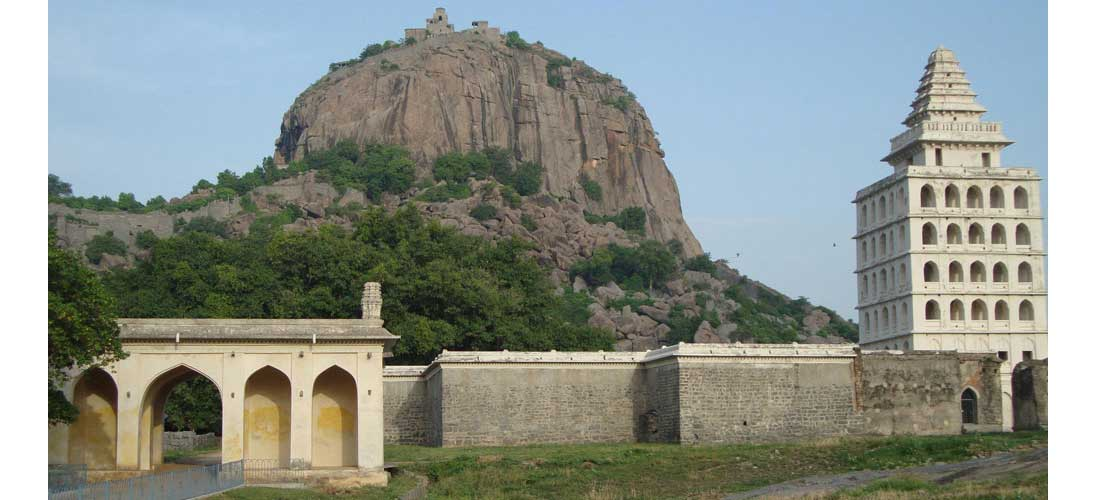Important Facts For Prelims
Gingee Fort Nominated for UNESCO World Heritage Site
- 24 Sep 2024
- 5 min read
Why in News?
Recently, the Gingee Fort in Tamil Nadu's Villupuram district has been nominated for UNESCO’s World Heritage Site list as part of the Maratha Military Landscapes proposal, which includes 11 other forts.
What are the Key Facts Regarding Gingee Fort of Tamil Nadu?
- Geographical Feature and Significance: Gingee Fort is renowned for its historical importance and strategic location atop three hillocks: Rajagiri, Krishnagiri, and Chandragiri.
- It is also known as the "Troy of the East," as it is one of the most impregnable fortresses in peninsular India.
- Its strategic location and robust defences, including a 60-foot-wide rampart and an 80-foot-wide moat, made it vital during the Carnatic Wars between the French and British.
- Historical Overview: The fort was originally built by Ananta Kon of the Konar Dynasty in 1200 CE and named it Krishnagiri.
- Vijayanagar Empire undertook significant renovations of the fort.
- In 1677, the fort was captured by Chhatrapati Shivaji and remained under Maratha control until 1698, when it fell to the Mughals.
- The Fort became the last stronghold for the Marathas (Rajaram I, son of Shivaji) during their resistance against the Mughal forces.
- Briefly ruled by Raja Desingh (Tej Singh), it was taken over by the Nawabs of Arcot in 1714 and remained under their dominion until 1749.
- From 1750 to 1770, the French held the fort before it eventually passed into Britishers.
- Architectural Features:
-
The fort complex houses several temples and shrines.
- It includes significant structures such as a stepped well, Kalyana Mahal, durbar hall, cannon, clock tower, armory, elephant tank, stable, granary, gymnasium, Venkataramana temple, and Sadathtulla mosque.
- Water Supply Systems: Gingee Fort features two sophisticated water supply systems, ensuring a continuous water supply even at the highest points of the fort.
-
Rajagiri Hill: It is the tallest hill at 800 metres, featuring a citadel and the temple of Ranganatha.
- Krishnagiri Citadel is notable for its Indo-Islamic architecture, including an audience hall with a domed roof.
- Venkataramana Swamy Temple: It is located in the Lower Fort complex and adorned with intricate carvings from Hindu epics.
- Kalyana Mahal: It is an architectural jewel with eight storeys, used as the royal ladies' quarters.
-
UNESCO World Heritage Site
- A World Heritage Site is a location recognized by UNESCO for its exceptional cultural or natural significance.
- UNESCO promotes the identification, protection, and preservation of cultural and natural heritage sites globally that hold outstanding value to humanity.
- As of September 2024, India has 43 World Heritage Sites (cultural sites-35, natural sites-7, mixed-criteria site-1) with the latest addition being the Mound-Burial System of Ahom Dynasty.
- Process for nominating a site to UNESCO's World Heritage List
- A country creates a list of important cultural and natural heritage sites.
- The country selects sites from the Tentative List and prepares nomination details.
- The International Council on Monuments and Sites (ICOMOS) and IUCN evaluate the nominated property.
- The Committee meets annually to decide which sites to add to the World Heritage List, based on advisory recommendations and criteria fulfillment.
Read More: Assam's Moidams to be Considered for World Heritage List, UNESCO, Maratha Military Landscapes
UPSC Civil Services Examination, Previous Year Question (PYQ)
Prelims:
Q. Which one of the following National Parks has a climate that varies from tropical to subtropical, temperate and arctic? (2015)
(a) Khangchendzonga National Park
(b) Nanda Devi National Park
(c) Neora Valley National Park
(d) Namdapha National Park
Ans: (d)





